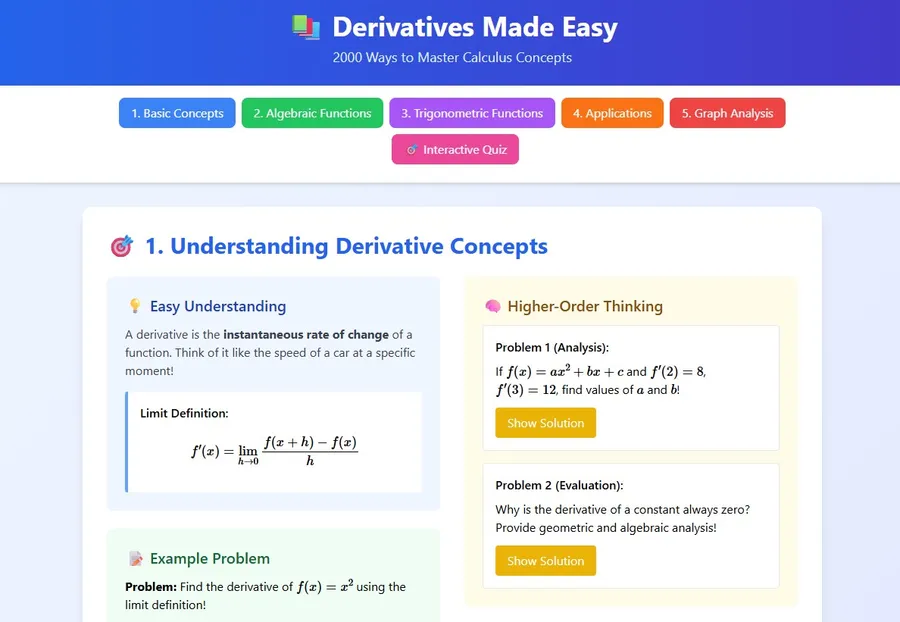Learn the concept of derivatives in calculus, including limits, slopes, rates of change, and real-life applications. Perfect for high school math.
Table Of Contents
📘 Discovering the Concept of Derivatives
Mastering the Fundamentals of Calculus with Simple Explanations and Real-Life Contexts
Understanding the concept of derivatives is fundamental in learning calculus for high school students. Whether you’re a beginner trying to grasp what is a derivative in calculus or someone looking to deepen your understanding, this topic opens doors to a wide range of real-world applications. At its core, a derivative represents the slope of a function or the rate of change, making it essential in fields like physics, economics, and engineering. By using the first principles derivative approach and mastering derivative using limits, students can build a strong foundation. This article also includes derivative examples, derivative problems and solutions, and visual derivative graph analysis to support intuitive learning. With a focus on real-life applications of derivatives, we aim to make derivative for beginners both accessible and engaging.
🧭 Introduction: Why Derivatives Matter
Have you ever wondered:
- How fast you’re going when driving?
- How quickly a disease spreads in a population?
- When a product’s sales start to decline?
These are all questions involving rates of change. And in mathematics, the derivative is the ultimate tool to describe and analyze change.
Derivatives lie at the heart of calculus, helping us understand everything from speeding cars to economic trends. Before diving into complex formulas, let’s build your intuition step-by-step.
🧱 Building Intuition: Derivatives as Instantaneous Change
Let’s say you walk 100 meters in 20 seconds. Your average speed is:
But what if you stopped halfway to check your phone? Or sprinted for the last 5 seconds?
Clearly, your instantaneous speed changes over time. That’s where derivatives come in — they let us calculate how fast something is changing at an exact moment.
Mathematically, this is represented by the slope of the tangent line at a single point on a graph.
🖼️ Visualizing Change: Secant vs. Tangent Lines
In a graph of a function , if we take two points and draw a line between them, we get a secant line. The slope of this line gives us the average rate of change between those two points.
As the two points get closer, the secant becomes the tangent line, which shows the instantaneous rate of change at a single point.
The derivative is simply the slope of this tangent line!
🧮 Formal Definition: The Limit of the Difference Quotient
Let’s look at the precise definition of a derivative:
This formula calculates the slope between two very close points and , and then takes the limit as , turning it into the tangent line slope.
📌 Terminology Recap:
- : Original function
- : Derivative of the function
- : A tiny change in
- Limit: What the value approaches as gets infinitely small
🔎 Example 1: Derivative of a Quadratic Function
Let . Find its derivative using the definition.
✅ So the derivative of is . This means the slope of the graph at any point is .
🌍 Real-Life Applications of Derivatives
1. Physics: Speed and Acceleration
If position = , then:
- Velocity =
- Acceleration =
This helps you understand how an object is moving and how fast it’s speeding up or slowing down.
2. Economics: Revenue and Cost Optimization
If:
- = revenue from selling items,
- tells how much additional revenue you’d get from selling 1 more item.
3. Medicine: Epidemic Spread
If is the number of infected people, then:
- tells how fast the disease is spreading.
📈 Derivatives and Graph Behavior
Derivatives help us analyze graph features like:
| Derivative Value | Meaning |
|---|---|
| Function is increasing | |
| Function is decreasing | |
| Function has a turning point |
You’ll use this later to sketch and interpret graphs (more in Article 5).
🧑🏫 Classroom Shortcut: Power Rule (Coming in Article 2)
For now, just remember this powerful shortcut:
If , then
You’ll use this in nearly every derivative problem — fast and effective!
🧪 Practice Questions (Basic Level)
1. Use the definition to find the derivative of the following:
🎯 HOTS Question: Critical Thinking
An object moves along a line with position function:
- Find the velocity function
- At what time(s) is the object at rest?
- When is the object moving forward?
🧠 Solution Sketch:
- Set to find rest points
- Analyze intervals where or
🔄 Reflect and Recap
Let’s review what you’ve learned:
| Concept | Meaning |
|---|---|
| Derivative | Instant rate of change or slope of a function |
| Limit of difference quotient | Formal definition of a derivative |
| Real-life use | Speed, business, population growth, physics |
| Graph analysis | Increasing, decreasing, turning points |
